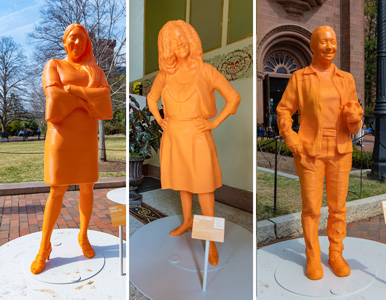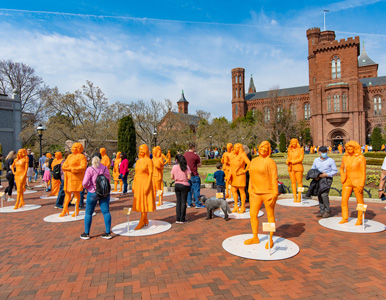
The largest collection of statues of women ever assembled includes oceanographers, astronomers, physicians—and a trio of Eagles.
The inaugural Women’s Futures Month, the Smithsonian’s “forward-looking celebration of the power of women and girls in STEM,” which coincides with Women’s History Month, kicked off March 5 with #IfThenSheCan, an exhibition featuring 3D-printed statues of 120 female innovators, including AU chemistry professor Raychelle Burks, statistician Davina Durgana, SIS/PhD ’15, and archaeologist Becca Peixotto, CAS/MA ’13, CAS/PhD ’17.
“Around the world, women have always contributed to advancing what we know about the natural and physical world. It’s an honor to join 119 of my peers in this exhibit that celebrates the vital work and achievements of women in STEM,” says Burks, an analytical chemist who designs new methods to detect a variety of drugs, explosives, and chemical weapons. “#IfThenSheCan expands the narrative about who is leading in STEM and hopefully helps the next generation see themselves as scientists in the making.”

During the exhibition’s opening weekend, the statues stood in the newly reopened Arts and Industries Building, the Smithsonian Castle, and the adjacent Enid A. Haupt Garden, as visitors mingled with the real-life women who inspired them. The collection then fanned out to the National Museum of National History and other locations on the Mall. The exhibition closes on March 27.
#IfThenSheCan, a partnership between the American Association for the Advancement of Science and Lydia Hill Philanthropies, “highlights how a more diverse, more inclusive workforce will strengthen our shared future,” says Smithsonian secretary Lonnie Bunch, CAS/BA ’74, MA ’76. Currently, women comprise less than 30 percent of the STEM workforce.
Peixotto—who is part of the team that announced the discovery of the first-ever partial skull of a Homo naledi child in South Africa last year—says she is honored to be part of a group of women whose collective work can help shape the next generation of STEM innovators.
“I’m in awe of and energized by all my fellow ambassadors,” says Peixotto, a project archaeologist for the Henry M. Jackson Foundation in support of the Defense POW/MIA Accounting Agency. “Everyone comes from different backgrounds, different paths to STEM, yet we’re all united by the If/Then mission to inspire more women and girls to pursue and succeed in STEM careers. There’s incredible power in that unity.”
#IfThenSheCan, which debuted last year at NorthPark Center Dallas, is also the lagrest 3D-printed project of its kind. It took 89 cameras, 25 projects, and 10 hours to create each statue. Organizers hope that, like the plastic from which they’re made, the impact of the statues on aspiring scientists and engineers will last a lifetime.